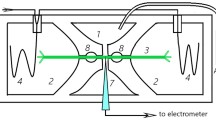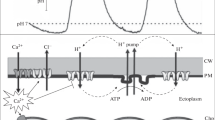Abstract
This paper reports data and considerations relevant to the question of what determines the polarity of the voltages induced between electrodes in a suspension of chloroplasts when irradiated with a flash of light from a laser or flash-lamp. We found positive polarity (electrode nearest the light source positive) with excitation by ns pulses at 694, 539 and 530 nm wavelength. This and the earlier finding (Meszéna et al. (1988) Studia Biophysica 126:77–86), confirmed in this work, of negative polarity at 420 nm confirm, in part, the action spectrum reported by Gräber and Trissl (1981 FEBS Let 123:95–99) using 50 μs flashes. Gräber and Trissl also showed that swelling the chloroplasts can reverse the polarity.
Negative polarity is expected on the basis of a simple light-gradient in the sample together with what is known about photosynthetic charge movements. The cause of positive polarities has eluded explanation. Duration of flash was suspected. We tried a random series of short flashes averaging about 10 μs apart and found that all simply duplicated the first flash. If there is any effect of light following the first flash it must occur in less than about 10 μs.
We suggest that the polarity is determined by a complicated interference pattern of the light in the chloroplast which can focus it onto different parts, front or back, depending upon the wavelength of the light and the structure of the chloroplast.
Similar content being viewed by others
Abbreviations
- DCMU:
-
3-(3′, 4′-dichlorophenyl)-1, 1 dimethylurea
- PSII:
-
photosystem II, the oxygen emitting system in green plant photosynthesis
- EDTA:
-
ethylenediaminetetraacetic acid
- Hepes:
-
N-2-Hydroxyethylpiperazine-N'-2-ethanesulfonic acid
References
Becher JF, Geacintov NE and Swenberg CE (1978) Photovoltages in suspensions of magnetically oriented chloroplasts. Biochim Biophys Acta 503: 545–554
Deprez J, Trissl H-W and Breton J (1986) Excitation trapping and primary charge stabilization in Rhodopseudomonas viridis cells, measured electrically with picosecond resolution. Proc Natl Acad Sci USA 83: 1699–1703
Fowler CF and Kok B (1974) Direct observation of a light-induced electric field in chloroplasts. Biochim Biophys Acta 357: 308–318
Gräber P and Trissl H-W (1981) On the rise time and polarity of the photovoltage generated by light gradients in chloroplast suspensions. FEBS Lett 123: 95–99
Meszéna G, Papp E and Fricsovszky G (1988) Study of the fast photoelectric signal from a chloroplast suspension. Studia Biophysica 126: 77–86
Minck RW, Terhune RW and Rado WG (1963) Laser-stimulated Raman effect and resonant four photon interactions in gases H2, D2 and CH4. Appl Phys Lett 3: 181–184
Trissl H-W, Kunze U, and Junge W (1982) Extremely fast photoelectric signals from suspensions of broken chloroplasts and of isolated chromatophores. Biochim Biophys Acta 682: 364–377
Trissl H-W (1983) Spatial correlation between primary redox components in reaction centers of Rhodopseudomonas sphaeroides measured by two electrical methods in the nanosecond range. Proc Natl Acad Sci USA 80: 7173–7177
Trissl H-W and Kunze U (1985) II. Primary electrogenic reactions in chloroplasts probed by picosecond flash-induced dielectric polarization. Biochim Biophys Acta 806: 136–144
Trissl H-W, Breton J, Deprez J and Leibl W (1987a) Primary electrogenic reactions of Photosystem II as probed by the light-gradient method. Biochim Biophys Acta 893: 305–319
Trissl H-W, Leibl W, Deprez J, Dobek A and Breton J (1987b) Trapping and annihilation in the antenna system of Photosystem I. Biochim Biophys Acta 893: 320–332
Author information
Authors and Affiliations
Rights and permissions
About this article
Cite this article
Meszéna, G., Devault, D. Investigations of the polarity of the photo-induced electrical signal of chloroplast suspensions. Photosynth Res 22, 115–122 (1989). https://doi.org/10.1007/BF00114771
Received:
Accepted:
Issue Date:
DOI: https://doi.org/10.1007/BF00114771




